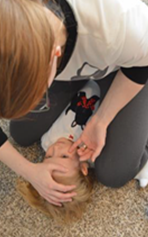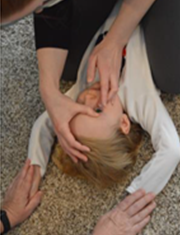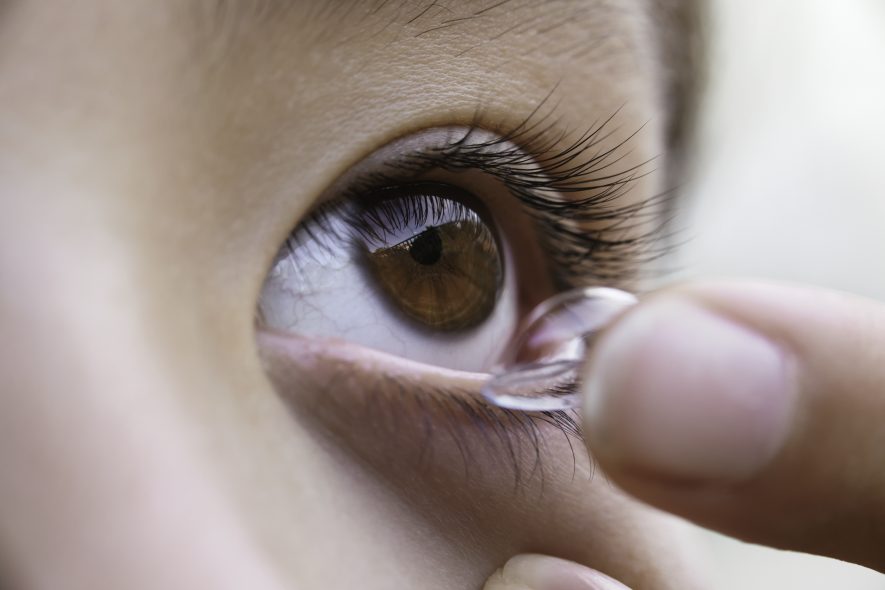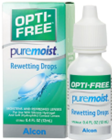Caring for Your Child After Pediatric Cataract Surgery
The care you provide your child after cataract surgery is crucial for their long-term vision. Aphakic contact lenses are imperative for visual development, especially in young children, as they allow the eye and brain to develop their critical connection for sight. Without corrective lenses, children risk developing amblyopia, or “lazy eye,” a condition where one or both eyes have reduced vision because the brain and the eyes are not working together properly. It happens when the brain begins to favor one eye — or fails to fully develop connections with either eye — causing poor visual development during early childhood.
Creating a Comforting Aphakic Lens Care Routine
- Safety First: Lay a blanket on a secure surface to prevent falls.
- Organization: Have tissues, paper towels, lenses, lens case, and solution within reach.
- Positive Motivation: Keep comfort items like a bottle, pacifier, blanket or favorite toy close by. Incorporating comfort items into your organization strategy can significantly improve the lens care experience, fostering a positive and cooperative environment.
- Patience and Breaks: If frustration arises, pause the activity and try again later for a better experience.
- Routine Development: Seamlessly blend lens care into your child’s schedule, creating a predictable pattern that helps them understand and anticipate the process.
- Familiarity and Comfort: Regular routines can significantly reduce resistance, as familiarity often leads to comfort and ease during lens care activities.
- Strategic Timing: Choose times when your child is generally more cooperative, such as after a meal or bath, to integrate lens care practices more smoothly.
Pre-Insertion Safety and Preparation Steps
Positioning Techniques for Lens Insertion
Infant Hold

Swaddle infants or have someone assist to keep your child steady without applying pressure on the chest or throat. It’s also perfectly fine to manage your baby’s lens care while they’re in a baby carrier. Just make sure they’re safely secured to prevent any falls.
1-Person Hold

A single caregiver can gently stabilize a toddler by straddling the child with their arms placed against their body. Use one hand to hold their head from moving and your other hand to assist with lens insertion. This approach offers safety and control without applying pressure, and works well for cooperative children or when help isn’t available.
2-Person Hold

Two adults work together to stabilize a child during contact lens insertion—one straddling the child securely and the other focused on holding the child’s arms. This method is ideal for children who are more active or resistant, ensuring safety, comfort, and precision during the lens care process.
- Hygiene: Wash and dry your hands thoroughly before starting. Keeping fingernails short helps to prevent accidental injury to the eye and makes handling the lens much easier. Once you’re confident and comfortable with the process, you may decide if longer nails work for you—but short nails are strongly recommended when you’re just starting.
- Preparing Your Contact Lens for Insertion: Pour the lens into the palm of your hand. Make sure the lens is the right way out.
Side View Method Place the lens on your fingertip with the edge facing upward. When viewed from the side, a properly oriented lens will resemble a smooth, symmetrical bowl with edges curving straight upward. If the edges flare outward, forming a shape similar to a rimmed soup bowl, the lens is inside out.
Taco Test Gently pinch the lens between your thumb and forefinger to form a taco shape. If the edges curve inward like a taco shell, the lens is correctly oriented. If the edges flare outward, resembling a soup spoon, the lens is inside out.
- Checking Contact Lenses for Safety: Always examine the lens for any signs of damage or scratches before putting it in. Do not use the lens if it appears damaged.
Step-by-Step: Inserting Aphakic Contact Lenses
- Gentle Handling: Use gentle techniques to open your child’s eyelids and insert the lens.
- Hold the Lens: With your main hand (the one you write with), gently hold the contact lens between your thumb and index finger. You’ll see which side of the lens should face outward — it’s slightly curved upwards like a small bowl.
- Open the Eyelids: Use your other hand to carefully open your child’s eyes. Place your fingers just above and below the eyelash line, lifting the upper lid up towards the eyebrow and pulling the lower lid down. This action helps to keep the eye wide open and prevents blinking. Eyelids flipping over during eye-opening attempts is a common issue. To avoid this, gently place your finger or thumb right at the eyelid’s edge, close to where it meets the eye. This technique helps maintain control over the eyelid for easier lens application.
- Insert the Lens: With the eye open, place the lens onto the lower part of the eye first, then gently slide it up under the upper eyelid. Make sure the lens is centered over the eye. The trick here is to let go of the lower eyelid first and then the upper eyelid. This method helps because the upper eyelid is stronger and might push the lens out if released too early.
Step-by-Step: Removing Aphakic Contact Lenses
- Opening the Eye: Just like when you’re putting in the lenses, gently open your child’s eye. Use one hand to lift the upper eyelid towards the eyebrow and the other to pull down the lower eyelid. Both of the following methods are effective. Choose the one that suits you and your child the best.
Method 1 – Pinching the Lens Out:
- Position Your Fingers: Place your thumb and index finger on either side of the lens, directly over your child’s iris (the colored part of the eye).
- Gently Pinch: Carefully press your fingers together to grasp the edge of the lens. Then, with a gentle push downwards, pinch the lens out between your fingers.
Method 2 – Using Eyelids to Remove the Lens:
- Position Your Thumbs: Put both of your thumbs on the edges of your child’s eyelids, right by the eyelashes.
- Pull and Push: Gently pull the eyelids apart, moving past the edges of the lens. Then, push the eyelids slightly inward and guide them under the lens edges. This motion will pop the lens out of the eye.
For Older Kids: Use your thumb and index finger to gently press on the lens over their iris. Push down and pinch together to remove the lens effectively.
Aphakic Contact Lens Maintenance and Cleaning
Daily Care
- Apply rewetting/tear drops (like Opti-Free puremoist rewetting drops, Systane tears, Refresh tears, etc) to the corner of your child’s closed eye (it will spread over the eye once they blink) about every two hours. Ideas to help remember would be during each diaper change, after naps, etc.
Weekly Care
- Cleaning Steps: After each removal, clean the lens by placing it in your palm. Apply three drops of Opti-Free puremoist and gently massage both sides with your other hand’s index finger. Rubbing firmly yet gently won’t damage the durable, soft lens.
- Rinsing: Thoroughly rinse both sides under a steady stream of Opti-Free Pure Moist for at least 20 seconds, using a closed sink to avoid losing the lens.
- Disinfecting: Once a week, store the lens in Opti-Free solution overnight in its case to disinfect.
- Always use new, unexpired lens care solutions.
- Do NOT use other solutions such as tap or bottled water or saliva to rinse, store or re-wet lenses. These could lead to a serious eye infection.
- Do NOT use cleaners containing Sorbic Acid, Potassium Sorbate, Hydrogen Peroxide, or Polyquad. These can damage the Silsoft lens surface and cause cloudiness.
Storage and Replacement
- Lens Storage: Always keep lenses completely immersed in the recommended solution when not being worn.
- Case Maintenance: Remember to clean your lens case whenever you clean your lenses.
- Replacement: If the lens is lost, cloudy, or has any tears or rips, call us so we can help get a replacement.
- Prescription Updates: The doctor may occasionally update the prescription. Do not use old lenses unless the doctor has specifically told you it’s okay.
- Dry Lens Reviving: If a lens dries out, apply saline and rehydrate gently. Do not force removal if stuck.
If Your Child Swallows a Lens
If your child eats a contact lens, rest assured it typically won’t hurt them. Call us so we can order a new one. However, it’s always a good idea to monitor them for any discomfort or unusual symptoms.
Debunking Common Contact Lens Myths
- Myth: A contact lens can get lost behind the eye.
- Fact: It’s physically impossible. If a lens is missing, check under the eyelids.
Recommended Aphakic Contact Lens Products
| Product | Brand |
| Silsoft Aphakic Contact Lens | Silsoft |
| Contact Lens Solution | Opti-Free PureMoist |
| Rewetting Drops | Opti-Free PureMoist |
| Storage Case | Provided with solution |
Silsoft aphakic contact lenses are the only soft lenses FDA-approved for overnight wear. These lenses are designed specifically for pediatric use and require Opti-Free PureMoist solution to ensure safe cleaning and longevity.
What is Aphakia? Why Contact Lenses Matter
Aphakia is a condition where the eye’s natural lens is absent, either due to surgical removal, congenital absence, or trauma. Aphakic contact lenses restore the eye’s ability to focus, enabling clear vision and supporting healthy visual development. Without correction, amblyopia (lazy eye) may develop, leading to permanent vision loss.
By wearing aphakic lenses consistently, children gain critical visual input during the most formative developmental years.
Navigating the Aphakia Journey with Confidence
You are not alone. Our pediatric ophthalmology team specializes in congenital and juvenile cataracts. We are here to provide clinical expertise, emotional support, and resources to help you care for your child every step of the way.
Resources for Families
We hope this guide empowers you with the tools and confidence to care for your child’s vision with aphakic contact lenses.







